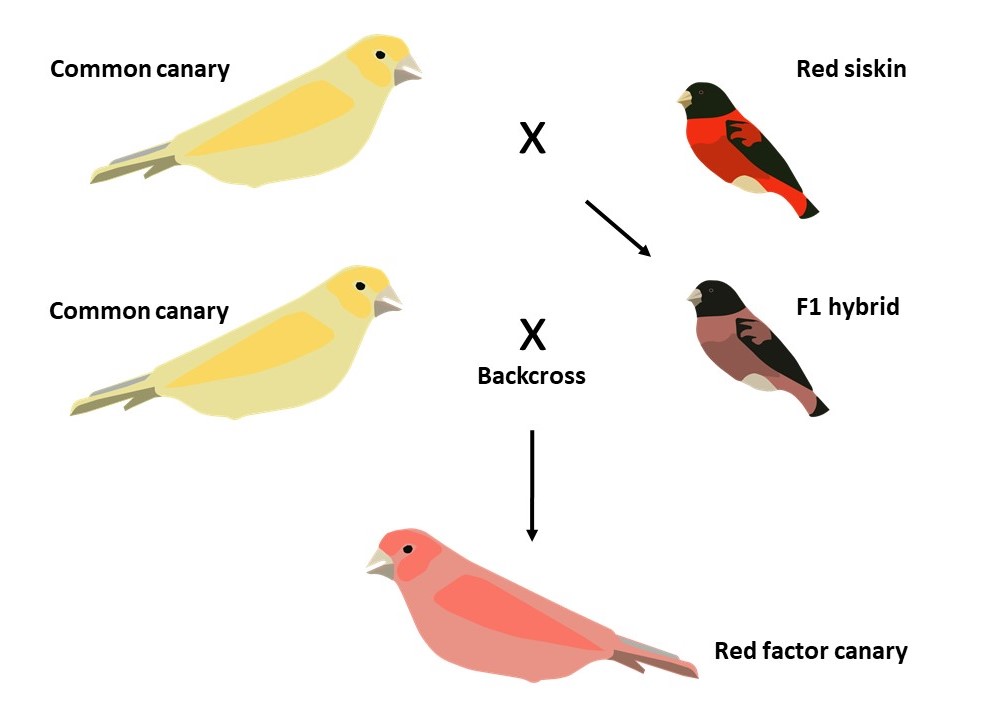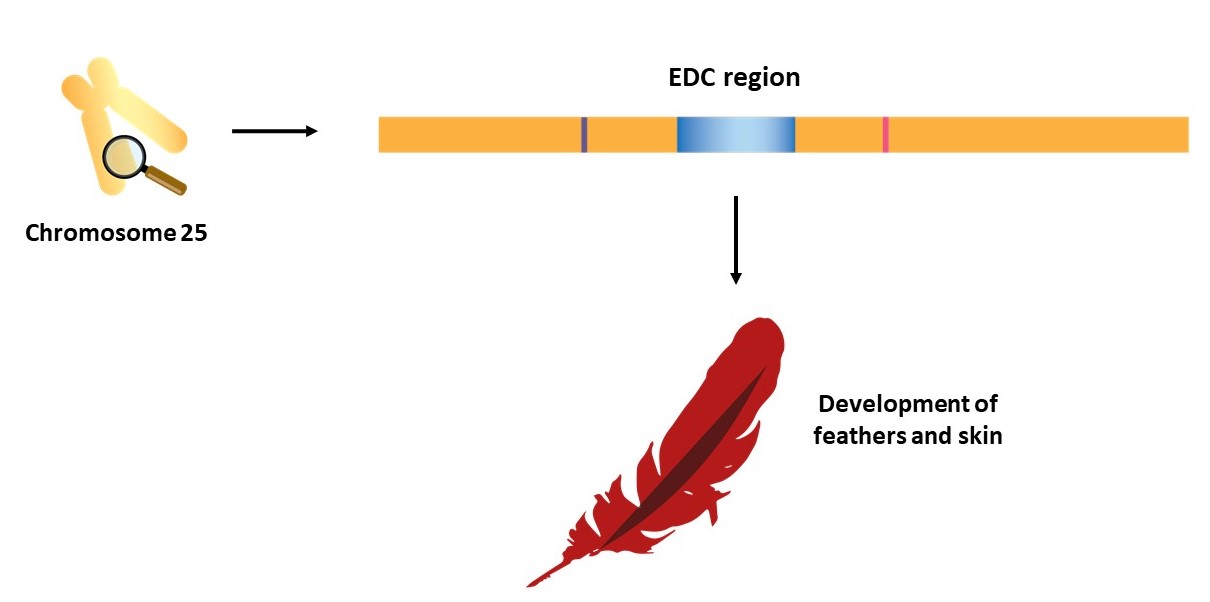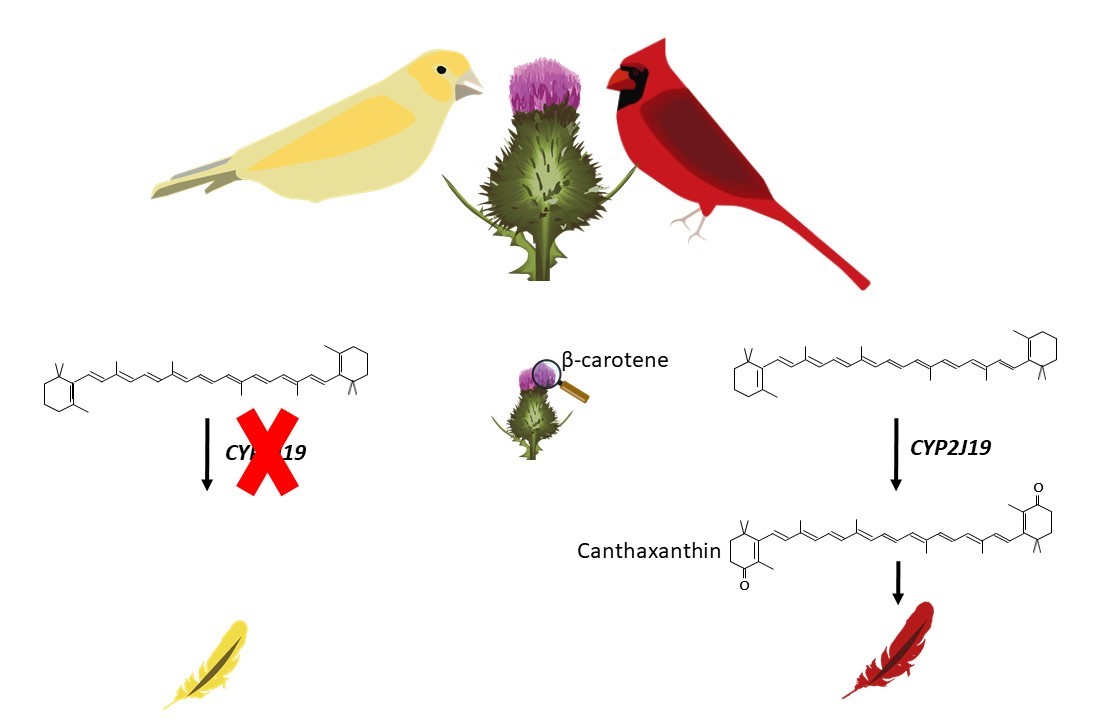You may have seen him perched up on tree branches, showing off his bright, red, feathery chest. The male Northern Cardinal, distinguished by his bright red feathers, has fascinated many birdwatchers and scientists alike. And, according to legend, if you see a cardinal flying toward the sun, you will have good luck. Even sports teams have succumbed to the Northern Cardinal’s enchantment. For instance, the name of this striking bird has been adopted by the St. Louis professional baseball team, the St. Louis Cardinals, and Phoenix’s American football NFL team the Arizona Cardinals. But, what is the relevance of the cardinal’s brilliant red feathers?

While pleasing to the human eye, the cardinal’s red plumage has a more specific and important function. Its most important purpose is to serve as a social cue leading to their thriving in the wild.
In fact, a 3-year study of this territorial bird, found that redder males have more offspring in a breeding season. Redder males also gain higher quality territories due to the red hue appearing more dominant to duller male cardinals. These redder cardinals also pair up with earlier breeding females. In addition, the male’s bright colored breast plumage has been positively correlated with parental care. Thus, the redder the male cardinal, the more successful he will be in the wild.
It’s well documented that a male cardinal’s bright red feathers lead to his success, but what really contributes to his coloration? Is it good genes, good health, a certain diet or something else?
For many, many years, scientists have mulled over the same question. Long ago, they found that red pigments in birds are produced when they ingest yellow carotenoids found in seeds, and metabolize them into red ketocarotenoids through an enzyme called ketolase. Interestingly, although both red and yellow birds ingest the same seeds, containing the same nutrients, only the red birds are able to metabolize the yellow dietary precursors into red ketocarotenoids, resulting in red plumage.

The identity of the ketocarotenoid-producing ketolase was unknown until the last few years, when scientists began to truly unravel the mechanisms underlying red feather pigmentation in canaries, giving insight into why many birds, including male cardinals, have such striking red plumage. Among these researchers were Lopes et al., who studied red coloration in birds by comparing the genomes of three canaries: red siskins, common canaries, and the product of crossing a red siskin with a canary, the “red factor” canary. They identified two genomic regions necessary to develop the red coloration. Remarkably, one of those regions contained the gene encoding CYP2J19, a cytochrome P450 enzyme, which is known to metabolize carotenoids. They also found that CYP2J19 was strongly expressed in skin and liver of red birds compared to yellow birds, suggesting that this enzyme might be responsible for the red coloration.
Development of red feathers also required a second region located in the epidermal differentiation complex (EDC) in chromosome 25, which contains over 50 genes that encode proteins necessary for feather and skin development in birds. These two genomic regions work together to give rise to red feathers, exactly how is still unknown.
The discovery of these two genomic regions is especially significant given that to other birds, the red feathers in the cardinal appear as a complex and attractive conglomeration of invisible colors. This is because the bird retina has 4 single cone-types (humans have 3) that are sensitive to various types of light, including ultraviolet light, allowing birds to see many more colors that the human eye cannot discern. Interestingly, one of the 4 cones in the avian retina, the red single cone, requires astaxanthin, a ketocarotenoid, to discriminate different colors. Indeed, Lopes et al. found that in addition to CYP2J19 being expressed in the liver and skin, it is also expressed in the red single cone and its levels correlates with astaxanthin production, indicating that CYP2J19 may be involved in ketocarotenoid production in the eye. We may reason that if CYP2J19 is responsible for the red coloration in birds, then it would be found in retinas of red birds and not in those of the yellow birds. However, Lopes et al. found similar levels of CYP2J19 in retinas of both yellow and red birds. Thus, both yellow and red birds have the ability to develop red feathers. The fact that only red birds do suggests CYP2J19 is regulated differently in red-feathered birds, including the cardinal.

Surprisingly, around the same time that Lopes and his team made this discovery, a different group studying color variation in the zebra finch made a similar discovery. Mundy et al. found that a homolog of CYP2J19, CYP2J19B, is found in red beaks of normal zebra finches but not in the beaks of yellow-beaked zebra finches. Now, the next step is to identify the factors regulating the expression of CYP2J19.
Such a discovery may also shed light into why the female cardinal exhibits a subdued tan feather color. Feather color in cardinals, as in other birds, is known to be a sex-limited trait, meaning feather color arises from differential regulation of genes in females and males resulting in sexual dimorphism. Perhaps the next question to answer is if CYP2J19 or its regulators are expressed differently in the female than in male cardinals, causing sexual dimorphism.
So, next time you see a vibrant red cardinal flying around in your backyard, you will not only have good luck, but you will have a better understanding of the complexity of the genetics behind color variation in birds.
References
Barsh, G. (2016). Evolution: Sex, Diet and Red Ketocarotenoids. Current Biology, 26(21). doi:10.1016/j.cub.2016.09.032.
Linville, S. U., Breitwisch, R., & Schilling, A. J. (1998). Plumage brightness as an indicator of parental care in northern cardinals. Animal Behaviour, 55(1), 119-127. doi:10.1006/anbe.1997.0595.
Mundy, N., Stapley, J., Bennison, C., Tucker, R., Twyman, H., Kim, K., . . . Slate, J. (2016). Red Carotenoid Coloration in the Zebra Finch Is Controlled by a Cytochrome P450 Gene Cluster. Current Biology, 26(11), 1435-1440. doi:10.1016/j.cub.2016.04.047.
Stoddard, M. C., & Prum, R. O. (2011). How colorful are birds? Evolution of the avian plumage color gamut. Behavioral Ecology, 22(5), 1042-1052. doi:10.1093/beheco/arr088.
Twyman, H., Andersson, S., & Mundy, N. I. (2018). Evolution of CYP2J19, a gene involved in colour vision and red coloration in birds: Positive selection in the face of conservation and pleiotropy. BMC Evolutionary Biology, 18(1). doi:10.1186/s12862-018-1136-y.
Wolfenbarger, L. L. (1999). Red coloration of male northern cardinals correlates with mate quality and territory quality. Behavioral Ecology, 10(1), 80-90. doi:10.1093/beheco/10.1.80.
Fernanda Ruiz is a science content writer at Gold Biotechnology. She holds a bachelor's of science in biology from St. Mary's University and a PhD in molecular biology from Baylor College of Medicine.
Category Code: 79101, 88241





